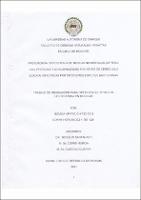Preferencia Ovipositoria de moscas Necrófagas (Diptera: Calliphoridae y Sarcophagidae). En carnes de cerdos (sus scrofa) infectadas por diferentes especies bacterianas.
Resumen
Los insectos son utilizados en la entomología forense principalmente para la estima
Del intervalo post-modem en fases tempranas de la descomposición. Los primeros
organismos en colonizar estos microsistemas que se forman son los dípteros y es
que luego de 72 horas es notable la presencia de lanas de estos insectos. El
objetivo de este estudio fue determinar las especies de larvas de moscas de las
familias Calliphoridae y Sarcophagidae de importancia forense capturadas
utilizando carne de cerdo inoculada con diferentes especies bacterianas, a fin de
identificar la preferencia de las hembras de las moscas adultas para la oviposición.
Para la colecta de las larvas se establecieron cuatro estaciones de muestreo
ubicadas en los distritos de Boquerón, Dolega y Bugaba. Se realizaron pruebas de
antibiograma para conocer la sensibilidad o resistencia de las bacterias frente a
diversos antibióticos. Las bacterias identificadas fueron Sfaphylococcus aureus,
Chromobacterium violaceum, Escherichia coli, Klebsiella pneumoniae, Serratia
marcescens, Streptococcus viridans, Pseudomona aeruginosa y Bacillus sp. De
éstas, las tres últimas presentaron mayor resistencia a los antibióticos, mientras
que, E. coli fue la que mayor sensibilidad presentó. Se determinó que la E2 ubicada
en Los Algarrobos, Dolega, fue la estación con mayor cantidad de larvas
recolectadas de Calliphoridae todas correspondientes a la especie Phormia regina
Cabe destacar que en Calliphoridae solo se obtuvieron larvas en cuatro de las ocho
bacterias utilizadas en los cebos arrojando una preferencia de las hembras a la hora
de ovipositar mientras que para Sarcophagidae se pudo determinar a través de una
prueba de Chi2 de Bondad de Ajuste que existe diferencia significativa en cuanto a
la cantidad de larvas obtenidas en las trampas, entre las estaciones de muestreo y
entre las especies bacterianas. Estas larvas se identificaron como Sarcophaga sp
y el mayor número se obtuvo del cebo correspondiente a Streptococcus viridans y
en la E1 ubicada en una zona boscosa en Macano, Boquerón. Insects are used in forensic entomology mainly for the estimation of the post-mortem
intervalin the early stages of decomposition. The first organisms to colonize these
microsystems that are formed are the diptera, and after 72 hours the presence of
larvae of these insects is notable. The objective of this study was to determine the
species of fly larvae of the families Calliphoridae and Sarcophagidae of forensic
importance captured using pig meat inoculated with different bacterialspecies, in
order to identify the preference of female adult flies for oviposition. For the collection
of the larvae, four sampling stations were established, located in the districts of
Boquerón, Dolega and Bugaba. Antibiogram tests were carried out to know the
sensitivity or resistance of the bacteria against various antibiotics. The bacteria
identified were Staphylococcus aureus, Chromobacterium violaceum, Escherichia
coli, Klebsiella pneumoniae, Serratia marcescens, Streptococcus viridans,
Pseudom0/7a aero/g/llosa and Bacllus sp. Of these, the last three presented the
highest resistance to antibiotics, while E. co// was the one with the highest sensitivity
It was determined that E2 located in Los Algarrobos, Dolega, was the station with
the highest number of collected larvae from Calliphoridae, all corresponding to the
Phornia regina species. It should be noted that in Calliphoridae larvae were only
obtained in four of the eight bacteria used in the baits. yielding a preference for
females when ovipositing .while for Sarcophagidae it could be determined through a
Chi2 Goodness of Fit test that exists. Significant difference in terms of the number
of larvae obtained in the traps, between sampling stations and between bacterial
species. These larvae were identified as Sarcophaga sp. and the highest number
was obtained from the bait corresponding to Sfrepfococcus virdans and on the E1
located in a wooded area in Macano. Boqueron.

